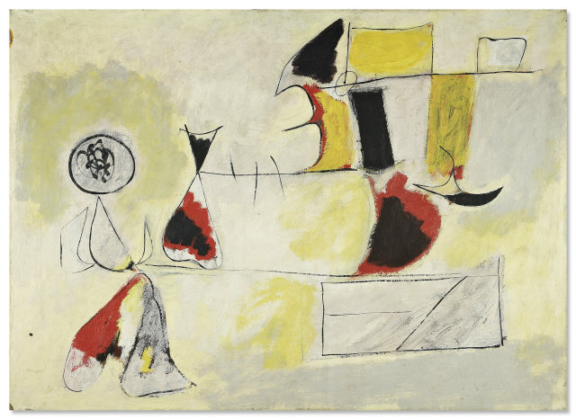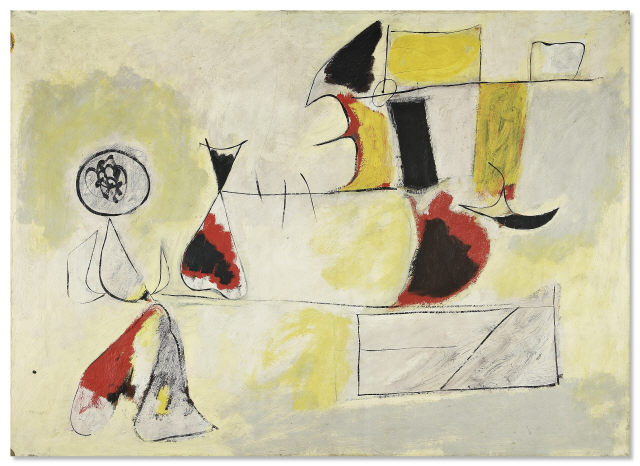
- 1944
- Canvas
- Oil
- Inv. 85PE69
Arshile Gorky
Garden of Wish Fulfilment
On a background of thick and opaque colour, created, as was customary of Gorky, by superimposing various layers of paint, which in this painting succeed in evoking a translucent and primordial atmosphere, Gorky draws the contours of various forms. The black, thin, quick, irregular line is very characteristic of his drawings from this period, revealing how Gorky learned to free his hand with the surrealist practice of automatic drawing. In this painting the forms evoke, in a particularly explicit and unique manner in his work from the final period, some models of Armenian ploughs, which are as if suspended in the composition, arranged along its horizontal axis. Although the planes of drawing and painting appear to be quite distinct here, creating greater distance than in his other compositions, Gorky succeeds in uniting them. To achieve this he uses his unique technique of preparing the canvas surface, creating a thick background of uneven, textured colour, which surrounds the forms. These forms are drawn in dynamic equilibrium, enhanced by the use of patches of colour – black, red and yellow –, which refrain from completely filling the forms and interact with each other.
Researchers on Gorky’s work coincide in reference to the beginning of the 1940s as a fundamental period of change in his creative process. Louis Finkelstein points to the union of surrealist automatism with the direct sensory experience of nature as the main reason for this creative metamorphosis. For Finkelstein, this process of abstraction is identical to that of the 1930s, which was however used in the formal stylistic context of cubism.* Prolonged contact with the countryside, from 1942 onwards, and the «revelation of the secret of surrealism»,** take him to new levels of abstraction, to the creation of «hybrid» images, as André Breton famously called them, born from the union of vision with fantasy and improvisation. Another simultaneous phenomenon, and one that was probably related to this one, occurs. By freeing his hand, and letting flow this unexpected iconography which was revealed to him through the almost microscopic observation of nature, his head immersed in the grass, the senses awakened by the incessant activity of the myriad of living organisms, Gorky liberates the pictorial evocation of his memories of Armenia and the painful experience of loss and separation which he had lived as a young boy. In this painting, which seems to be intended for his youngest and closest sister, Vartoosh Mooradian, this memory is as if sublimated and simplified. The forms are recognisable, in an atmosphere which is sweetly evocative of a shared past.
Ana Vasconcelos
May 2010
* Finkelstein cited by Melvin P. Lader, «What the drawings reveal. Some Observation on Arshile Gorky’s Working Method», in Arshile Gorky. A Retrospective of Drawings, New York, Whitney Museum of American Art and Harry N. Abrams, 2003, p. 42.
** «Arshile Gorky – for me the first painter to whom the secret (of Surrealism) has been completely revealed!», Breton cited by Janie C. Lee, «Arshile Gorky. The Power of Drawing», in idem, p. 63.
| Type | Value | Unit | Section |
| Height | 74 | cm | |
| Width | 103 | cm | |
| Width | 113,5 | cm | |
| Depth | 5 | cm | |
| Height | 85 | cm |
| Type | Acquisition |
| Arshile Gorky Adoian |
| Chicago, E.U.A., Gilgamesh Press Limited, 1978 |
| Monografia |
| Arshile Gorky: Colecção Mooradian |
| Lisboa, Fundação Calouste Gulbenkian, Centro de Arte Moderna, Outubro de 1984 |
| Catálogo de exposição |
| The Painters and their Sculpture - From Edgar Degas to Gerhard Richter |
| Essen, Alemanha, DuMont Editora, 1997 |
| Catálogo de exposição |
| Heimo Zobernig e a Colecção do Centro de Arte Moderna da Fundação Calouste Gulbenkian/ Heimo Zobernig and the Collection of the Calouste Gulbenkian Foundation Modern Art Centre; Heimo Zobernig and the Tate Colllection/ Heimo Zobernig e a Colecção da Tate |
| Lisboa/ St. Ives, 2009 |
| ISBN:978-1-85437-826-2 |
| Catálogo de exposição |
| Arshile Gorky: Colecção Mooradian |
| CAM/FCG |
| Curator: Karlen Mooradian (1935-1990) |
| 24 de Outubro 1984 a Desconhecida Centro de Arte Moderna da Fundação Calouste Gulbenkian |
| Janeiro de 1985 a Desconhecida Centro Cultural Português, Fundação Calouste Gulbenkian |
| Comemoração do 80º aniversário do nascimento de Gorky. Incluiu trabalhos realizados entre 1927 e 1947. |
| Gorky + Desenhos Ingleses |
| CAM/FCG |
| Curator: A definir |
| 7 de Março 1996 a 19 de Maio de 1996 Galeria do piso -1 do CAM/JAP |
| Não tem catálogo. |
| O Perfume das Maçãs: obras de Arshile Gorky |
| CAMJAP/FCG |
| Curator: Ana Vasconcelos e Melo |
| 27 de Março de 2003 a 29 de Junho de 2003 Centro de Arte Moderna José de Azeredo Perdigão, Fundação Calouste Gulbenkian |
| Não tem catálogo. |
| The Painters and their Sculpture - From Edgar Degas to Gerhard Richter |
| Museu Folkwang |
| Curator: A definir |
| 12 de Outubro 1997 a 04 de Janeiro 1998 Museu Folkwang, Essen. |
| Be-Bomb: The Transatlantic War of Images and all that Jazz in the 1950s |
| Museu d'Art Contemporani de Barcelnoa (MACBA) |
| Curator: Museu d'Art Contemporani de Barcelnoa (MACBA) |
| 5 de Outubro 2007/5 de Fevereiro 2008 a 8 de Janeiro de 2008/6 de Maio de 2008 Barcelona |
| O MACBA, Museu de Arte Contemporânea de Barcelona e o Museo Nacional Centro de Arte Reina Sofia, organizaram uma exposição intitulada "Be-Bomb: The Transatlantic War of Images and all that Jazz in the 1950s", apresentada nas duas instituições a título itinerante. |
| Heimo Zobernig e a Colecção do Centro de Arte Moderna da Fundação Calouste Gulbenkian |
| CAM/FCG |
| Curator: Jürgen Bock |
| 11 de Fevereiro de 2009 a 31 de Agosto Centro de Arte Moderna |
| Exposição realizada em parceria com a Tate St. Ives. Inclui obras da colecção da Tate de St. Ives, do Centro de Arte Moderna e do artista Heimo Zobernig. De 24 de Maio a 31 de Agosto de 2009 estiveram expostas apenas as obras do CAM escolhidas pelo artista. |
| Exposição Permanente do CAM |
| CAM/FCG |
| Curator: Jorge Molder |
| 18 de Julho de 2008 a 4 de Janeiro de 2009 Centro de Arte Moderna |
| Exposição Permanente entre 18 de Julho de 2008 a 4 de Janeiro de 2009. |
